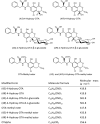Risk assessment of ochratoxin A in food
- PMID: 37649524
- PMCID: PMC10464718
- DOI: 10.2903/j.efsa.2020.6113
Risk assessment of ochratoxin A in food
Abstract
The European Commission asked EFSA to update their 2006 opinion on ochratoxin A (OTA) in food. OTA is produced by fungi of the genus Aspergillus and Penicillium and found as a contaminant in various foods. OTA causes kidney toxicity in different animal species and kidney tumours in rodents. OTA is genotoxic both in vitro and in vivo; however, the mechanisms of genotoxicity are unclear. Direct and indirect genotoxic and non-genotoxic modes of action might each contribute to tumour formation. Since recent studies have raised uncertainty regarding the mode of action for kidney carcinogenicity, it is inappropriate to establish a health-based guidance value (HBGV) and a margin of exposure (MOE) approach was applied. For the characterisation of non-neoplastic effects, a BMDL 10 of 4.73 μg/kg body weight (bw) per day was calculated from kidney lesions observed in pigs. For characterisation of neoplastic effects, a BMDL 10 of 14.5 μg/kg bw per day was calculated from kidney tumours seen in rats. The estimation of chronic dietary exposure resulted in mean and 95th percentile levels ranging from 0.6 to 17.8 and from 2.4 to 51.7 ng/kg bw per day, respectively. Median OTA exposures in breastfed infants ranged from 1.7 to 2.6 ng/kg bw per day, 95th percentile exposures from 5.6 to 8.5 ng/kg bw per day in average/high breast milk consuming infants, respectively. Comparison of exposures with the BMDL 10 based on the non-neoplastic endpoint resulted in MOEs of more than 200 in most consumer groups, indicating a low health concern with the exception of MOEs for high consumers in the younger age groups, indicating a possible health concern. When compared with the BMDL 10 based on the neoplastic endpoint, MOEs were lower than 10,000 for almost all exposure scenarios, including breastfed infants. This would indicate a possible health concern if genotoxicity is direct. Uncertainty in this assessment is high and risk may be overestimated.
Keywords: Ochratoxin; dietary exposure assessment; hazard characterisation; margin of exposure approach; risk characterisation.
© 2020 European Food Safety Authority. EFSA Journal published by John Wiley and Sons Ltd on behalf of European Food Safety Authority.
Figures











Similar articles
-
Risk assessment of small organoarsenic species in food.EFSA J. 2024 Jul 2;22(7):e8844. doi: 10.2903/j.efsa.2024.8844. eCollection 2024 Jul. EFSA J. 2024. PMID: 38957748 Free PMC article.
-
Dietary glycation compounds - implications for human health.Crit Rev Toxicol. 2024 Sep;54(8):485-617. doi: 10.1080/10408444.2024.2362985. Epub 2024 Aug 16. Crit Rev Toxicol. 2024. PMID: 39150724
-
Update of the risk assessment of nickel in food and drinking water.EFSA J. 2020 Nov 5;18(11):e06268. doi: 10.2903/j.efsa.2020.6268. eCollection 2020 Nov. EFSA J. 2020. PMID: 33193868 Free PMC article.
-
Occurrence of ochratoxin A in breast milk and urine samples of nursing mothers in Bangladesh.Mycotoxin Res. 2024 Feb;40(1):135-146. doi: 10.1007/s12550-023-00510-5. Epub 2023 Dec 1. Mycotoxin Res. 2024. PMID: 38038834 Free PMC article.
-
Application of the margin of exposure (MoE) approach to substances in food that are genotoxic and carcinogenic: example: ethyl carbamate (CAS 51-79-6).Food Chem Toxicol. 2010 Jan;48 Suppl 1:S63-8. doi: 10.1016/j.fct.2009.10.032. Food Chem Toxicol. 2010. PMID: 20113856 Review.
Cited by
-
Potential of fruit seeds: Exploring bioactives and ensuring food safety for sustainable management of food waste.Food Chem X. 2024 Aug 6;23:101718. doi: 10.1016/j.fochx.2024.101718. eCollection 2024 Oct 30. Food Chem X. 2024. PMID: 39246690 Free PMC article.
-
Disposable Electrochemical Aptasensor Based on Graphene Oxide-DNA Complex as Signal Amplifier towards Ultrasensitive Detection of Ochratoxin A.Micromachines (Basel). 2022 May 26;13(6):834. doi: 10.3390/mi13060834. Micromachines (Basel). 2022. PMID: 35744448 Free PMC article.
-
Fusarium Mycotoxins and OTA in Beer from Shanghai, the Largest Megacity in China: Occurrence and Dietary Risk Assessment.Foods. 2023 Aug 16;12(16):3071. doi: 10.3390/foods12163071. Foods. 2023. PMID: 37628069 Free PMC article.
-
Ochratoxin A: Overview of Prevention, Removal, and Detoxification Methods.Toxins (Basel). 2023 Sep 8;15(9):565. doi: 10.3390/toxins15090565. Toxins (Basel). 2023. PMID: 37755991 Free PMC article. Review.
-
Human Proximal Tubule Epithelial Cells (HK-2) as a Sensitive In Vitro System for Ochratoxin A Induced Oxidative Stress.Toxins (Basel). 2021 Nov 6;13(11):787. doi: 10.3390/toxins13110787. Toxins (Basel). 2021. PMID: 34822571 Free PMC article.
References
-
- Abdel‐Wahhab MA, Abdel‐Galil MM and El‐Lithey M, 2005. Melatonin counteracts oxidative stress in ratsfed an ochratoxin A contaminated diet. Journal of Pineal Research, 38, 130–135. - PubMed
-
- Abdel‐Wahhab MA, Abdel‐Azim SH and El‐Nekeety AA, 2008. Inulacrithmoides extract protects against ochratoxin A‐induced oxidative stress, clastogenic and mutagenic alterations in male rats. Toxicon, 52, 566–573. - PubMed
-
- Abid S, Hassen W, Achour A, Skhiri H, Maaroufi K, Ellouz F, Creppy E and Bacha H, 2003. Ochratoxin A and human chronic nephropathy in Tunisia: is the situation endemic? Human and Experimental Toxicology, 22, 77–84. - PubMed
LinkOut - more resources
Full Text Sources
